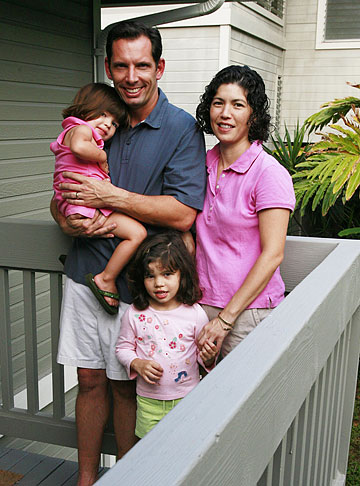HAWAII'S BRAIN DRAIN REVERSES

CINDY ELLEN RUSSELL / CRUSSELL@STARBULLETIN.COM
The Ott family posed for a portrait yesterday outside of their home. Lori was born in Hawaii and returned back to the isles with her husband, Mark, to raise their daughters Claire, 4, and Anne, 2.
|
|
Move-to-mainland tide turns
A robust economy reduces the exodus of the leaner 1990s
In 1997, Mark and Lori Ott, married and starting on their careers, looked at the job market in Hawaii and the cost of living and decided to leave for the mainland.
Two kids later, the Otts moved back home from Minneapolis last year, and Lori Ott, a Punahou School graduate, said she has noticed many of her classmates are doing the same thing.
GRASS LOOKING GREENER IN ISLES
U.S. Census figures show a dramatic decline in the number of people leaving Hawaii:
11,820: The average net number of people leaving Hawaii per year in the 1990s
2,053: The average net number of people leaving Hawaii per year from 2000 to 2004
|
"My family is from here, and it was important to us for our children to understand Hawaii, their roots here in Hawaii," Lori Ott said.
The Otts are part of a movement helping to reduce the net number of people leaving Hawaii for the mainland.
According to a Census Bureau report released today, the net number of people leaving Hawaii in what the census calls domestic migration went from 118,201 in the 1990s to just 8,213 between 2000 and 2004.
It was so bad in the 1990s that Hawaii's population saw a net drop, with an average of 11,820 people moving to the mainland each year. But in this decade the average number of people moving out of state is just 2,053 per year, according to the census report.
The change is the largest in the nation.
State economist Pearl Imada Iboshi attributes the increase to Hawaii's booming economy, which turned around in the beginning of this decade.
Rebecca Parker, president of M. Dyer and Sons Inc. movers, said in the 1990s about 70 percent of the people her company moved were leaving Hawaii. Now the ratio is about 60 percent outbound and 40 percent inbound.
During the 1990s, Parker said, she moved a lot of retirees looking for a lower cost of living and young people in the first five years of their careers seeking better opportunities.
Now, some of the same people she moved to the mainland are calling because they are moving back, she said.
Kazu Sugiki, a Realtor with Maui Realty Co., said that in the 1990s he sold a lot of homes of retirees who took the profits and moved to Las Vegas.
"They used to go to Las Vegas because homes are cheaper," Sugiki said. "Not anymore, because prices in Las Vegas are very high, too."
Even though domestic migration is pulling people away from Hawaii, the state's population still increased by an average of 12,719 people a year or 1 percent in this decade to 1,262,124 in 2004, Imada Iboshi said.
Natural growth due to births and people living longer increased Hawaii's population by an average of 9,200 people a year, and immigration from other countries accounted for an average increase of 5,572 people a year.
The census report shows Hawaii also reflects a national trend of people moving out of cities and into areas where housing is more affordable.
Even though the state saw population declines in the 1990s and into this decade, the Big Island's and Maui's populations continued to increase.
Much of the state's out-migration was because of people leaving Honolulu, Imada Iboshi said.
Maui had an average increase of 476 people per year in the 1990s and now sees a net increase of about 746 per year this decade.
The Big Island saw an average net migration of 873 people per year in the 1990s. That number has more than doubled this decade to 1,988 per year.
"The big pull here is that (housing) prices are so reasonable," said Hilo Realtor J.J. Jasinski. "Prices are lower so you don't feel so pressured into making a lot of money."
Nationally, the census report showed nearly every large metropolitan area in the country had more people move out than move in from 2000 to 2004, with a few exceptions in the South and Southwest.
Northeasterners are moving South and West. West Coast residents are moving inland. Midwesterners are chasing better job markets.
The states that attracted the most new residents: Florida, Arizona and Nevada. The states that lost the most: New York, California and Illinois.
The Associated Press contributed to this report.

